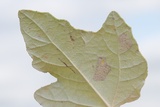Phyllonorycter comparella (Duponchel, [1843]) Species
Last modified: Dec. 10, 2025, 4:44 p.m.
A fairly common species in Belgium, especially in Flanders at the coastal area. In the southern part of the country it is very rare.
Details
- Classification
- Family: Gracillariidae > Subfamily: Lithocolletinae > Genus: Phyllonorycter > Species: Phyllonorycter comparella
- Vernacular names
- Abeelvouwmot (NL), Winter poplar midget (EN), Pappel-Blattminiermotte (DE)
- First mention in Belgium
- De Crombrugghe G. 1909. Observations microlépidoptérologiques faites en 1908. — Annales de la Société Entomologique de Belgique 53: 44–47. On page 46. view page
- Status
-
Native
Distribution
Mine
Oval tentiform mine on the underside of a leaf between two secondary veins, showing no longitudinal folds. On the underside the mine is hardly visible as is has almost the same colour as the rest of the leaf, on the upperside, however, the mine is visible as a lighter green or yellowish blotch than the rest of the leaf. The sides of the mine are lighter and a green spot remains in the center, but it grows gradually smaller when the caterpillar consumes the leaf tissue. The frass is contained in a corner of the mine.
See also gracillariidae.net and bladmineerders.be.
Bionomics
The eggs are deposited on the underside of a leaf, and there can be several mines on the same leaf. Pupation inside the mine. The adults rest during the day on tree trunks and in the foliage. They become active at dusk and come to light.
Flight periods
Two generations a year flying in May/June and August.
Observed on
- Host plant (species):
- Populus alba and Populus canescens
The larva lives exclusively on Populus alba or Populus canescens.








